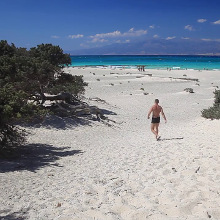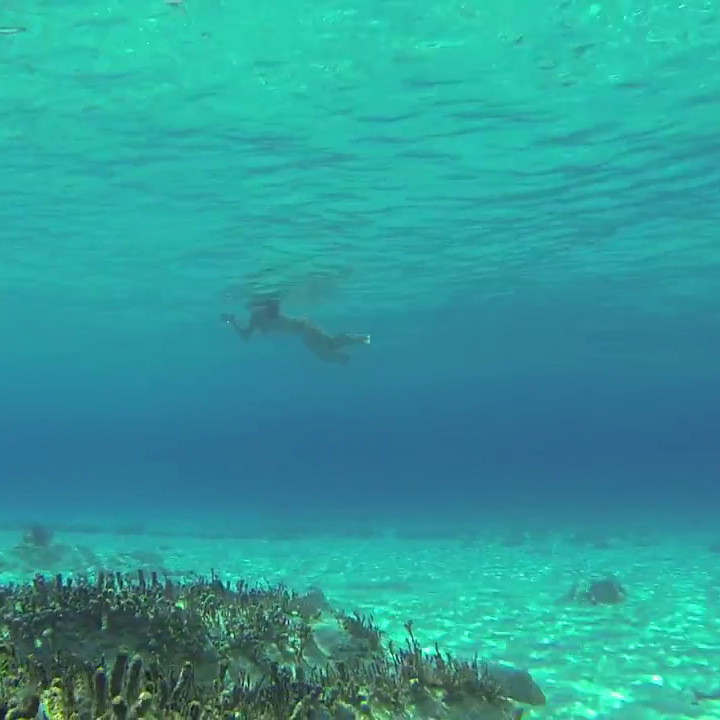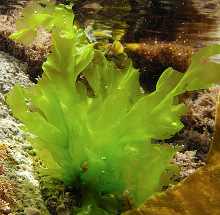Is the sea clean? A useful mini guide Share it on Facebook
 Summer!! Weather for cool baths! Mat, sunscreen, mask and flippers and we are ready to go straight to the sea. Some times, our initial entousiasm is over as we reach the beach and see the sea filled with our known seaweed, these brown black ribbons that have either flooded the beach and have no space to stretch our towel or have darkened the color at the bottom of the sea, usually causing us a sense of resentment and fear. Around us, other disappointed bathers leave saying "... the sea is dirty, it has seaweed ...". How true is this?
Summer!! Weather for cool baths! Mat, sunscreen, mask and flippers and we are ready to go straight to the sea. Some times, our initial entousiasm is over as we reach the beach and see the sea filled with our known seaweed, these brown black ribbons that have either flooded the beach and have no space to stretch our towel or have darkened the color at the bottom of the sea, usually causing us a sense of resentment and fear. Around us, other disappointed bathers leave saying "... the sea is dirty, it has seaweed ...". How true is this?
Can the blue flags be a first indication of the purity of the sea you swim, but how can you check the quality of seawaters even with a naked eye before you swim?
Let's get things better from scratch. These seaweeds (or "algae") are actually not algae but evolving superior sea plants called Posidon or Posidonia (Posidonia oceanica). Posidonia is related to the land plants that we see around us, such as wheat, corn, palm trees, roses, etc. Posidonia lives completely immersed in seawater. Like all the upper plants on the land, Posidonia has roots, stems, leaves, as well as flowers and fruits. So with its roots anchored in the sand of the seabed. Its leaves can reach 1 meter in length and their color is green. However, as the leaves age, they become dark brown and fall from the plant as it is new. The aged leaves will be swept away by the waves and will be blown into the sand, and basically these are the brown ribbons we often encounter on the beaches. Although the presence of Posidonia causes a lot of dislike and the impression that the waters are dirty, it is important to emphasize that Posidonia grows exclusively in clear waters. So, when you see Posidonia on the sandy beach or in the shallows, then swim safely, the sea is pure!
 Except from Posidonia it is posible to see algae mainly on the rocks of the sea.The algae, are evolving inferior sea plants with no roots, shoots, flowers and fruits.
The algae are also very common on the sea shores, but unlike Posidonia, you will not find them on sandy beaches but on the rocks of the sea. Those who love diving from rocks or swimming with a mask on rocky shores will surely have seen them.
They are these small plants, usually brown in color, which often look like small shrubs. Their size is small in Greece, usually does not exceed 20-30 cm.
The algae have a huge variety of colors - besides brown algae there are also green, red, yellow, white etc. Their shapes also vary greatly because there are species like strip or small leaves, with fan or umbrellas, while others resemble jelly. In Greece, there are approximately 600 species of algae.
Sea rocks covered with brown algae are an indication that the sea is crystal clear!
But the important thing with algae is that they are very good indicators of water purity and are used by scientists as biomarkers to control the quality of the sea. This use of algae is based on the fact that there are some species found only in clear waters while in polluted seas disappear.
On the contrary, there are some other species of algae that prefer polluted water.
Generally, brown and relatively large algae grow in clean seas, such as Cystoseira species that look like small shrubs or trees and have a harsh texture. In Greece, these species are very common in small depths (0-1 meter) in clean seas, and if you see them on the rocks, you will know for sure that you are swimming in clear waters.
Except from Posidonia it is posible to see algae mainly on the rocks of the sea.The algae, are evolving inferior sea plants with no roots, shoots, flowers and fruits.
The algae are also very common on the sea shores, but unlike Posidonia, you will not find them on sandy beaches but on the rocks of the sea. Those who love diving from rocks or swimming with a mask on rocky shores will surely have seen them.
They are these small plants, usually brown in color, which often look like small shrubs. Their size is small in Greece, usually does not exceed 20-30 cm.
The algae have a huge variety of colors - besides brown algae there are also green, red, yellow, white etc. Their shapes also vary greatly because there are species like strip or small leaves, with fan or umbrellas, while others resemble jelly. In Greece, there are approximately 600 species of algae.
Sea rocks covered with brown algae are an indication that the sea is crystal clear!
But the important thing with algae is that they are very good indicators of water purity and are used by scientists as biomarkers to control the quality of the sea. This use of algae is based on the fact that there are some species found only in clear waters while in polluted seas disappear.
On the contrary, there are some other species of algae that prefer polluted water.
Generally, brown and relatively large algae grow in clean seas, such as Cystoseira species that look like small shrubs or trees and have a harsh texture. In Greece, these species are very common in small depths (0-1 meter) in clean seas, and if you see them on the rocks, you will know for sure that you are swimming in clear waters.
 On the other hand, algae that prefer polluted waters are usually green and look like strips or leaves, and have a soft texture that sometimes resembles jelly.In this group is well known the species Ulva, which is also called lettuce of the sea because of its similarity to our famous lettuce. These algae grow in large quantities in polluted harbors, moles, marinas, near sewage drains, massively covering the surface of rocks at very small depths - usually at the point where the waves break. Therefore, if you go to a beach and find large green masses of algae on the rocks (usually visible without having to enter the water) then you have to be suspicious that you are not on the cleanest beach of the world ...
When the green algae flood everything better choose another beach for your activity (swimming, fishing, etc).
On the other hand, algae that prefer polluted waters are usually green and look like strips or leaves, and have a soft texture that sometimes resembles jelly.In this group is well known the species Ulva, which is also called lettuce of the sea because of its similarity to our famous lettuce. These algae grow in large quantities in polluted harbors, moles, marinas, near sewage drains, massively covering the surface of rocks at very small depths - usually at the point where the waves break. Therefore, if you go to a beach and find large green masses of algae on the rocks (usually visible without having to enter the water) then you have to be suspicious that you are not on the cleanest beach of the world ...
When the green algae flood everything better choose another beach for your activity (swimming, fishing, etc).
Also the bad smell and the bubbles in the shallows is an indication that the sea probably is not clean. The next time you are on the beach be observant,to understand the ecological status of the sea you are going to swim or fishing.




